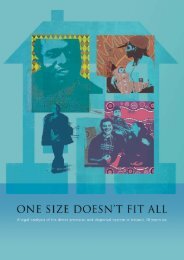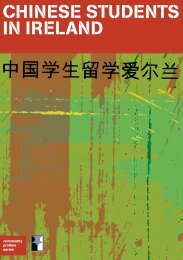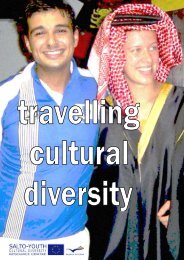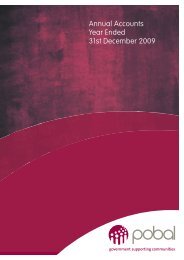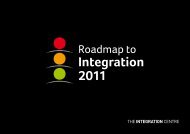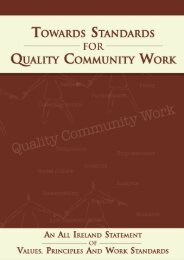1THE CONTEXT OF INTERCULTURAL EDUCATIONThe more people who are on <strong>the</strong> marg<strong>in</strong>s <strong>the</strong> weaker is <strong>the</strong> centre…we all have a stake <strong>in</strong> build<strong>in</strong>g a future which respects and celebratesdiversity—a generous shar<strong>in</strong>g Ireland that encompasses manytraditions and cultures and creates space for all its people.(President Mary McAleese, 24 February 2000)The growth of immigration <strong>in</strong>to Irelands<strong>in</strong>ce <strong>the</strong> mid-1990s has brought <strong>the</strong> issueof ethnic and cultural diversity to <strong>the</strong>forefront and has encouraged discussionaround diversity. However, it would not beaccurate to suggest that Ireland has onlyrecently experienced diversity. Significantm<strong>in</strong>ority ethnic, l<strong>in</strong>guistic and religiousgroups have long been part of Irish society.Ireland has a long history of culturaldiversity that has contributed to mak<strong>in</strong>gIreland <strong>the</strong> country it is today. In a widersense, membership of a European andglobal community has also played asignificant role <strong>in</strong> <strong>the</strong> experience of be<strong>in</strong>gIrish. In <strong>the</strong> context of grow<strong>in</strong>g diversity,and grow<strong>in</strong>g awareness of diversity, issuesof discrim<strong>in</strong>ation, particularly racialdiscrim<strong>in</strong>ation, have come <strong>in</strong>to focus. Antidiscrim<strong>in</strong>ationhas been written <strong>in</strong>to Irishlaw and <strong>in</strong>to education policy. All <strong>the</strong>sefactors comb<strong>in</strong>e to provide <strong>the</strong> backgroundwith<strong>in</strong> which <strong>the</strong>se guidel<strong>in</strong>es operate.ETHNIC AND CULTURAL DIVERSITY IN IRELANDThe growth <strong>in</strong> ethnic and cultural diversity<strong>in</strong> Ireland <strong>in</strong> recent years has arisen for anumber of reasons, <strong>in</strong>clud<strong>in</strong>g <strong>in</strong>creasedmovement from o<strong>the</strong>r EU countries (Table2), as well as <strong>in</strong>creases <strong>in</strong> asylum seekers(Table 4) and <strong>in</strong> those issued work permits(Table 3). This diversity is not, however, anentirely new phenomenon: Ireland has, <strong>in</strong>fact, a long history of cultural diversity.Table 1: Place of birth of people usually liv<strong>in</strong>g<strong>in</strong> Ireland <strong>in</strong> Census figures,1991 and 2002Place of Birth 1991 2002Ireland 93.9 % 89.6 %Nor<strong>the</strong>rn Ireland 1.0 % 1.3 %Great Brita<strong>in</strong> 3.8 % 5.1 %O<strong>the</strong>r EU 0.4 % 0.9 %USA 0.4 % 0.6 %O<strong>the</strong>r Countries 0.6 % 2.5 %Total 100 % 100 %2<strong>Intercultural</strong> <strong>Education</strong> <strong>in</strong> <strong>the</strong> <strong>Post</strong> <strong>Primary</strong> <strong>School</strong>
THE CONTEXT OF INTERCULTURAL EDUCATION 1Table 2: Estimated immigration to Ireland of people of EU nationality1996 1997 1998 1999 2000 2001 2002UK 8,300 8,200 8,300 7,900 7,100 7,000 5,100Rest of EU 5,000 5,500 5,800 6,800 7,100 5,800 6,100Note: A substantial number of those <strong>in</strong>cluded <strong>in</strong> <strong>the</strong> above statistics are not immigrants <strong>in</strong> <strong>the</strong> strict sensebut return<strong>in</strong>g Irish migrants. The figure for return<strong>in</strong>g Irish migrants peaked <strong>in</strong> 1999, at 55 per cent of allmigrants. At present is it under 40 per cent.As EU citizens, Irish people enjoy <strong>the</strong> rightto move to o<strong>the</strong>r EU states. O<strong>the</strong>r EUcitizens, <strong>in</strong>clud<strong>in</strong>g <strong>the</strong> 10 countries thatjo<strong>in</strong>ed <strong>the</strong> EU <strong>in</strong> May 2004, also enjoy <strong>the</strong>same right, and many have chosen to liveand work <strong>in</strong> Ireland. From May 2004 toApril 2005 85,114 people from <strong>the</strong> tenaccession countries were allocated PersonalPublic Service Numbers (PPS No) <strong>in</strong>Ireland. We cannot be certa<strong>in</strong> that all thosepeople are now work<strong>in</strong>g <strong>in</strong> Ireland but itwould be <strong>the</strong> <strong>in</strong>tention of <strong>the</strong> majority ofthose apply<strong>in</strong>g for PPS Nos to work. Thismovement of people across Europeanborders has contributed to a culturalexchange between European countries aswell as afford<strong>in</strong>g people an opportunity toidentify <strong>the</strong> similarities that underlie ourEuropean identity.Dur<strong>in</strong>g <strong>the</strong> economic boom years of <strong>the</strong>late 1990s and early 2000s, significantlabour shortages developed which had anegative impact on economic growth.The number of workers from EU countrieswas not sufficient to meet <strong>the</strong> economy’slabour needs. As a result, work permitswere issued to non-EU citizens to fillspecified jobs. Apart from EU citizensliv<strong>in</strong>g <strong>in</strong> Ireland, significant numbers ofmigrant workers have come to Irelandfrom countries such as Russia, Romania,<strong>the</strong> Philipp<strong>in</strong>es, South Africa and <strong>the</strong>Ukra<strong>in</strong>e.Table 3: Employment migration to Ireland fromoutside <strong>the</strong> EU2000 18,000 work permits issued2001 36,000 work permits issued2002 40,000 work permits issued2003 47,551 work permits issued2004 34,067 work permits issuedAno<strong>the</strong>r group of recent immigrants toIreland comprises those who are seek<strong>in</strong>gasylum. The asylum process is designed toprotect those who have a well-founded fearof persecution <strong>in</strong> <strong>the</strong>ir country of orig<strong>in</strong>. Inorder to protect such people, <strong>the</strong> right toask for asylum was written <strong>in</strong>to <strong>the</strong>Universal Declaration of Human Rights.Those who are granted asylum are knownas refugees. The numbers of asylum seekersand refugees <strong>in</strong>ternationally grew dur<strong>in</strong>g<strong>the</strong> 1980s and early 1990s. In <strong>the</strong> UK, forexample, <strong>the</strong> number of asylum seekersgrew from 2,905 <strong>in</strong> 1984 to 22,005 <strong>in</strong>1990 and 44,845 <strong>in</strong> 1991. In Ireland, at<strong>the</strong> same time, <strong>the</strong> number of peopleseek<strong>in</strong>g asylum rarely rose above 50. In1991 it stood at 31.<strong>Intercultural</strong> <strong>Education</strong> <strong>in</strong> <strong>the</strong> <strong>Post</strong>-<strong>Primary</strong> <strong>School</strong> 3








